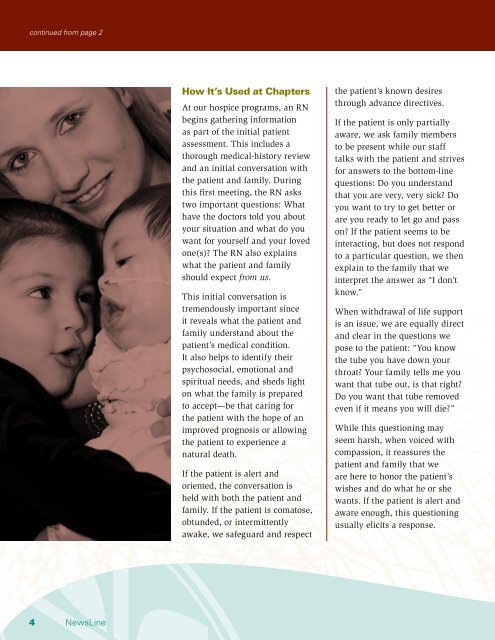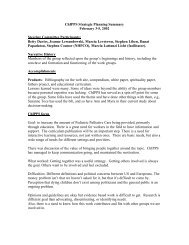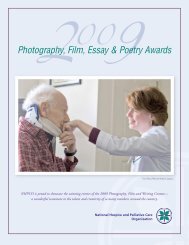PDF version - National Hospice and Palliative Care Organization
PDF version - National Hospice and Palliative Care Organization
PDF version - National Hospice and Palliative Care Organization
You also want an ePaper? Increase the reach of your titles
YUMPU automatically turns print PDFs into web optimized ePapers that Google loves.
continued from page 2<br />
How It’s Used at Chapters<br />
At our hospice programs, an RN<br />
begins gathering information<br />
as part of the initial patient<br />
assessment. This includes a<br />
thorough medical-history review<br />
<strong>and</strong> an initial conversation with<br />
the patient <strong>and</strong> family. During<br />
this first meeting, the RN asks<br />
two important questions: What<br />
have the doctors told you about<br />
your situation <strong>and</strong> what do you<br />
want for yourself <strong>and</strong> your loved<br />
one(s)? The RN also explains<br />
what the patient <strong>and</strong> family<br />
should expect from us.<br />
This initial conversation is<br />
tremendously important since<br />
it reveals what the patient <strong>and</strong><br />
family underst<strong>and</strong> about the<br />
patient’s medical condition.<br />
It also helps to identify their<br />
psychosocial, emotional <strong>and</strong><br />
spiritual needs, <strong>and</strong> sheds light<br />
on what the family is prepared<br />
to accept—be that caring for<br />
the patient with the hope of an<br />
improved prognosis or allowing<br />
the patient to experience a<br />
natural death.<br />
If the patient is alert <strong>and</strong><br />
oriented, the conversation is<br />
held with both the patient <strong>and</strong><br />
family. If the patient is comatose,<br />
obtunded, or intermittently<br />
awake, we safeguard <strong>and</strong> respect<br />
the patient’s known desires<br />
through advance directives.<br />
If the patient is only partially<br />
aware, we ask family members<br />
to be present while our staff<br />
talks with the patient <strong>and</strong> strives<br />
for answers to the bottom-line<br />
questions: Do you underst<strong>and</strong><br />
that you are very, very sick? Do<br />
you want to try to get better or<br />
are you ready to let go <strong>and</strong> pass<br />
on? If the patient seems to be<br />
interacting, but does not respond<br />
to a particular question, we then<br />
explain to the family that we<br />
interpret the answer as “I don’t<br />
know.”<br />
When withdrawal of life support<br />
is an issue, we are equally direct<br />
<strong>and</strong> clear in the questions we<br />
pose to the patient: “You know<br />
the tube you have down your<br />
throat? Your family tells me you<br />
want that tube out, is that right?<br />
Do you want that tube removed<br />
even if it means you will die?”<br />
While this questioning may<br />
seem harsh, when voiced with<br />
compassion, it reassures the<br />
patient <strong>and</strong> family that we<br />
are here to honor the patient’s<br />
wishes <strong>and</strong> do what he or she<br />
wants. If the patient is alert <strong>and</strong><br />
aware enough, this questioning<br />
usually elicits a response.<br />
4 NewsLine









